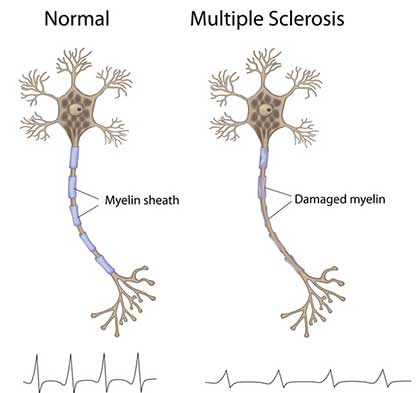An introduction to MS:

MS is a disorder of the central nervous system (CNS) which includes the brain, spinal cord and optic nerves.
The CNS is responsible for our conscious and unconscious functioning, including movement and the response to sensations such as sight, touch and hearing. It directs these functions by sending its instructions in the form of electrical impulses to the appropriate sites along nerve fibres.
Nerve fibres are coated in a protective insulating covering called the myelin sheath—this serves a very similar function to the coating around electrical wires. Myelin is important in speeding electrical conduction along nerve fibres and in insulating nerve fibres from one another.
Watch our short video explaining what MS is
Download our ‘What is MS‘ leaflet here.
The term multiple sclerosis refers to multiple areas of scarring (sclerosis) scattered throughout the brain and spinal cord. These scars are the result of healing patches of inflammation that are the basic cause of damage to nerve fibres and of the suddenly appearing symptoms that are referred to as an attack, exacerbation or relapse.
Patches of inflammation heal spontaneously over several weeks or months when symptoms may resolve completely or residual impairment may result, if they do not. The inflammation causes damage particularly to the insulating myelin sheath covering nerve fibres, but also damages the nerve fibres (axons) themselves.
In MS, the typical damage is often referred to as “demyelination”. The nature of the symptoms and their severity depends partly on the site of the patch of inflammation (or lesion) and partly on its nature and intensity.
Using data from the MSNZ funded MS Prevalence Study (2006) and MS Incidence Study (2012-14) we estimate that about one New Zealander in every thousand has MS. Thus, there are just over 4000 people in New Zealand diagnosed with MS.
It is more common in:
MS is not contagious or infectious; it is not possible to contract it from close contact with a person with MS.
The course of MS varies widely from person to person. Some people will only ever experience mild symptoms over their lifetime while others will have relapses followed by incomplete remission when disability may worsen in a stepwise fashion with each relapse experienced. A number of people experience slowly progressive, worsening of disability over many months or years. There is uncertainty how much of this progressive process is due to low-grade inflammation and how much to loss of previously damaged nerve fibres.
The cause of MS is still not known.
Both genetic and environmental factors are important, but how they interact to produce episodes of localised inflammation over many years is not clear.
MS is widely regarded as an autoimmune disease. Here the body produces a misdirected immune system attack on its own tissue—in this case the myelin sheath that protects the axons, but that has never been firmly established. A reaction to a virus hidden in the CNS has been long suspected, but also not proven.
In persons with MS, the immune system appears to be normal in all other respects. MS is not a hereditary disorder in the sense of being passed directly from parent to child. The increased risk in close family members is not attributable to a single gene, but most likely related to several genes whose function is not well understood—some of these probably influence the body’s immune reactions.
A striking environmental feature is the increase in prevalence of MS in higher latitudes both above and below the equator. In NZ, for example, the prevalence in the South Island is approximately twice that in the upper half of the North Island. The pattern of migration from Northern Europe may contribute to that distribution, levels of sunlight exposure and Vitamin D, or other undetermined environmental factors. Among many possibilities, exposure early in life to a virus infection that has a long-term effect on immune responses is also being considered. However, none of the numerous viruses suspected can be directly linked at present.
Further info:
What is MS? – MSNZ
What causes MS? – National MS Society
Is MS genetic? – MS Trust
Is MS hereditary or not? – MS Trust
Risk of developing MS – MS Trust
What is MS? – MS Trust
MS and its treatments: a presentation by Neurologist Dr Jennifer Pereira – MS Auckland
What is the social and economic impact of MS in New Zealand? – MSNZ